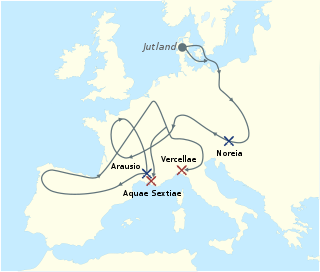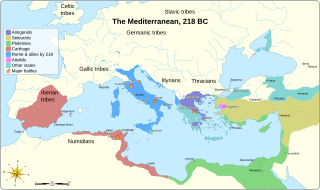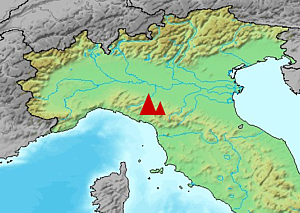Related Research Articles

The Battle of Aquae Sextiae (Aix-en-Provence) took place in 102 BC. After a string of Roman defeats, the Romans under Gaius Marius finally defeated the Teutones and Ambrones. The Teutones and the Ambrones were virtually wiped out, with the Romans claiming to have killed 200,000 and captured 90,000, including large numbers of women and children who were later sold into slavery. Some of the surviving captives are reported to have been among the rebelling gladiators in the Third Servile War. Local lore associates the name of the mountain, Mont St. Victoire, with the Roman victory at the battle of Aquae Sextiae, but Frédéric Mistral and other scholars have debunked this theory.

The Ambrones were an ancient tribe mentioned by Roman authors. They are generally believed to have been a Germanic tribe from Jutland.

In ancient geography, the Ligures Baebiani were a settlement of Ligurians in Samnium, Italy.
The Hirpini were an ancient Samnite tribe of Southern Italy. While generally regarded as having been Samnites, sometimes they are treated as a distinct and independent nation. They inhabited the southern portion of Samnium, in the more extensive sense of that name, roughly the area now known as Irpinia from their name—a mountainous region bordering on Basilicata towards the south, on Apulia to the east, and on Campania towards the west. No marked natural boundary separated them from these neighboring nations, but they occupied the lofty masses and groups of the central Apennines, while the plains on each side, and the lower ranges that bounded them, belonged to their more fortunate neighbors. The mountain basin formed by the three tributaries of the Vulturnus —the Tamarus, Calor, and Sabatus, which, with their valleys, unite near Beneventum, surrounded on all sides by lofty and rugged ranges of mountains—is the center and heart of their territory. They occupied the Daunian Mountains to the north, while its more southern portion comprised the upper valley of the Aufidus and the lofty group of mountains where that river takes its rise.
The Salyes or Salluvii were an ancient Celto-Ligurian people dwelling between the Durance river and the Greek colony of Massalia during the Iron Age. Although earlier writers called them 'Ligurian', Strabo used the denomination 'Celto-ligurian', and a Celtic influence is noticeable in their religion, which centred on the cult of the tête coupée. In fact, the Salyes were most likely at the head of a political and military confederation that united both Gallic and Ligurian tribes.
Appius Claudius Pulcher was a Roman politician of the 2nd century BC.
Marcus Popillius Laenas was a Roman statesman.

The Battle of Insubria in 203 BC was the culmination of a major war, carried out by the Carthaginian commander Mago, son of Hamilcar Barca, at the end of the Second Punic war between Rome and Carthage in what is now northwestern Italy. Mago had landed at Genoa, Liguria, two years before, in an effort to keep the Romans busy to the North and thus hamper indirectly their plans to invade Carthage's hinterland in Africa. He was quite successful in reigniting the unrest among various peoples against the Roman dominance. Rome was forced to concentrate large forces against him which finally resulted in a battle fought in the land of the Insubres (Lombardy). Mago suffered defeat and had to retreat. The strategy to divert the enemy's forces failed as the Roman general Publius Cornelius Scipio laid waste to Africa and wiped out the Carthaginian armies that were sent to destroy the invader. To counter Scipio, the Carthaginian government recalled Mago from Italy. However, the remnants of the Carthaginian forces in Cisalpine Gaul continued to harass the Romans for several years after the end of the war.

The Apuani were one of the most formidable and powerful of the Ligurian tribes who lived in ancient north-western Italy, mentioned repeatedly by Livy. From the circumstances related by him, it appears that they were the most easterly of the Ligurian tribes, who inhabited the lofty group of mountains bordering on Etruria, and appear to have occupied the valleys of the Macra and Ausar. Although they extended eastwards along the chain of the Apennines to the frontiers of the Arretines and the territory of Mutina and Bononia, the upper valley of the Macra about Pontremoli, including the area later known as Lunigiana where the Tuscan towns of Aulla, Fivizzano, Fosdinovo, Villfranca and Pontremoli are now found, and the adjoining Upper Garfagnana and Ligurian districts of Sarzana and La Spezia were their center.
The Briniates were an ancient Ligurian tribe mentioned by Livy as being subjugated by Rome under consuls Marcus Aemilius Lepidus and Quintus Mucius Scaevola in 175 BCE. They inhabited the valley of the Vara.
The Garuli were an ancient Ligurian tribe mentioned by Livy as being subjugated by Rome under consuls Marcus Aemilius Lepidus and Quintus Mucius Scaevola in 175 BCE. They inhabited the area of Cenisola.
The Hercates or Hergates were an ancient Ligurian tribe mentioned by Livy as being subjugated by Rome in 175 BCE.
The Lapicini were an ancient Ligurian tribe mentioned by Livy as being subjugated by Rome under consuls Marcus Aemilius Lepidus and Quintus Mucius Scaevola in 175 BCE. They inhabited the extreme northern regions of Liguria, as it was defined in Roman times, on a tributary of the Magra river.

The Cenomani, was an ancient tribe of the Cisalpine Gauls, who occupied the tract north of the Padus, between the Insubres on the west and the Veneti on the east. Their territory appears to have extended from the river Addua to the Athesis. Whether these Cenomani are the same people as the Cenomani in Gallia Celtica encountered by Julius Caesar is a subject of debate.

Old Latium is a region of the Italian peninsula bounded to the north by the river Tiber, to the east by the central Apennine mountains, to the west by the Mediterranean Sea and to the south by Monte Circeo. It was the territory of the Latins, an Italic tribe which included the early inhabitants of the city of Rome. Later it was also settled by various Italic tribes such as the Rutulians, Volscians, Aequi, and Hernici. The region was referred to as "old" to distinguish it from the expanded region, Latium, that included the region to the south of Old Latium, between Monte Circeo and the river Garigliano – the so-called Latium adiectum. It corresponded to the central part of the modern administrative region of Lazio, Italy, and it covered an area measuring of roughly 50 Roman miles. It was calculated by Mommsen that the region's area was about 1860 square kilometres.
The Roman–Volscian wars were a series of wars fought between the Roman Republic and the Volsci, an ancient Italic people. Volscian migration into southern Latium led to conflict with that region's old inhabitants, the Latins under leadership of Rome, the region's dominant city-state. By the late 5th century BC, the Volsci were increasingly on the defensive and by the end of the Samnite Wars had been incorporated into the Roman Republic. The ancient historians devoted considerable space to Volscian wars in their accounts of the early Roman Republic, but the historical accuracy of much of this material has been questioned by modern historians.

The Battle of the Isère River took place near the modern day French town of Valence at the confluence of the Isère and Rhône rivers. A first confrontation had been won by Gnaeus Domitius Ahenobarbus at the Battle of Vindalium, further south in the Rhône Valley. Domitius and Quintus Fabius Maximus Allobrogicus joined their forces and defeated a confederation of Allobroges, Arverni and some Salluvii warriors at the Isère River.
The Intimilii or Intemelii were a Ligurian tribe dwelling on the Mediterranean coast, around present-day Ventimiglia, during the Iron Age and the Roman period.
The Ingauni were a Ligurian tribe dwelling on the Mediterranean coast, around the modern city of Albenga, during the Iron Age and the Roman period.
References
-
 This article incorporates text from a publication now in the public domain : Smith, William, ed. (1854–1857). Dictionary of Greek and Roman Geography . London: John Murray.Missing or empty
This article incorporates text from a publication now in the public domain : Smith, William, ed. (1854–1857). Dictionary of Greek and Roman Geography . London: John Murray.Missing or empty |title=(help)